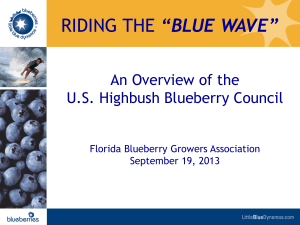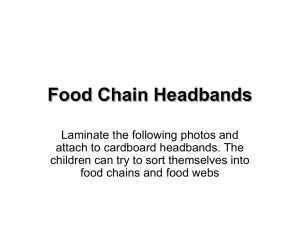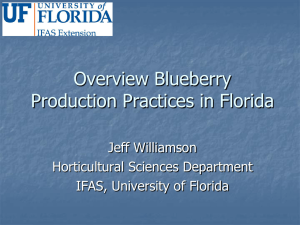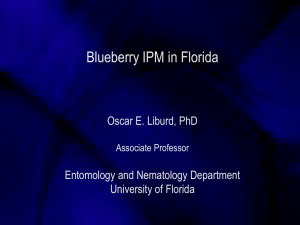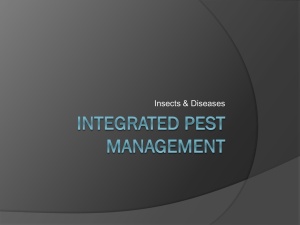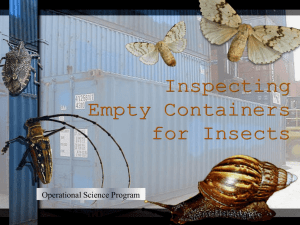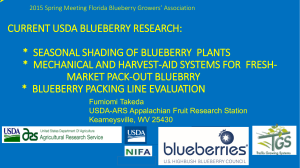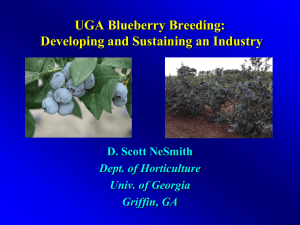White grubs and other bad blueberry bugs
advertisement
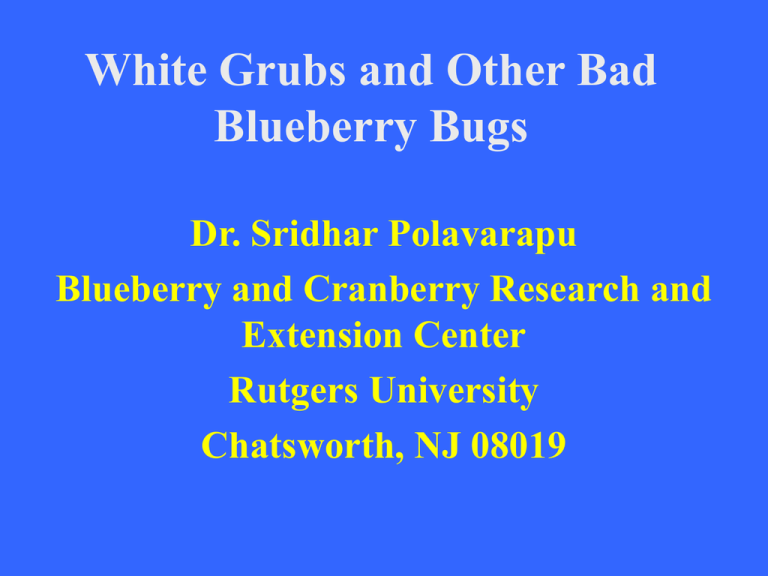
White Grubs and Other Bad Blueberry Bugs Dr. Sridhar Polavarapu Blueberry and Cranberry Research and Extension Center Rutgers University Chatsworth, NJ 08019 In This Presentation …. • Seasonal lifehistory and management of above ground pests • Pests feeding on roots Seasonal Lifehistory and Management of Major Pests • Pests that occur during the dormant stage • Pre-bloom leaf and flower feeders • Bloom-time insect pests • Post-bloom pests on foliage and fruit Pests During Dormant Stage • Putnam scale is the main concern • Problem in under-pruned fields • Superior oil (70-second type) @ 3 gal/ac • Lime sulfur @ 5 gal/ac • Apply on warm days (>50 F) before flower buds begin to open Pre-bloom Leaf and Flower-Feeders • Cranberry weevil, leafrollers, and spanworms are the major pests • ET of one larvae per 100 clusters for caterpillars • For CW, treat if >5 weevils per bush or 20% injured flower clusters Bloom-time Insect Pests • Gypsymoth larvae, leafrollers, and aphids are the main concern • Bts and Confirm 2F are the insecticide options • Same threshold as pre-bloom • No aphid controls during bloom Post-bloom Pests on Foliage and Fruit • Cranberry fruitworm, plum curculio, blueberry aphids, and blueberry maggot are the major pests • Leafminers, and leafrollers are occassional problems • Most insecticide applications are made during this phase Post-bloom Pests on Foliage and Fruit Cranberry fruitworm • Single generation per year • Pheromone traps are used for monitoring • Single insecticide application 5-7 days after the peak • Typical timing June 1-5 Effect of timing of Confirm 2F applications on efficacy against Cranberry Fruitworm 20 Larvae per 100 Clusters 15 % Damaged Clusters a a 10 5 b b b 0 b b b Confirm 6/1&6/8 a b b Diazinon 6/1&6/8 Confirm 5/25&6/1 Confirm 6/1 Control CFW 2000 Post-bloom Pests on Foliage and Fruit Blueberry aphids • A complex of several species • Vectors of blueberry scorch and other viruses •Species identified in NJ blueberries • Illinoia azaleae • Ericaphis spp. • Macrosiphum euphorbiae, M. rosae • Aphis spiraecola, A. gossypii • Myzus persicae Post-bloom Pests on Foliage and Fruit Constraints in Managing Blueberry Aphids Natural enemies • Low tolerance because of vector status • Use of broadspectrum insecticides leading to natural enemy destruction • Poor coverage Evaluation of Imidacloprid Applied as Soil Drench Against Blueberry Aphids • Imidacloprid treatments at 0.25 and 0.5 lb A.I./acre were evaluated as soil drench • Four replications, 3 bushes per replication • Insecticide was applied in 1000 mL per bush on June 7 • Aphids were sampled on June 14 and 21 Evaluation of imidacloprid applied as soil drench 80 60 a a a a % IT a a a b 40 b 20 a 300 Pre-spray 6/7 1st Post-spray 6/14 2nd Post-spray 6/21 Total Aphids ab 200 a a a a 100 b b b 0 Control Imidacloprid 0.25 lb.ai/ac Imidacloprid 0.5 lb.ai/ac Evaluation of Foliar Applications • Imidacloprid, Thiamethoxam, and Thiacloprid were evaluated • Four replications, four bushes per replication in a single row • R&D sprayer, 30 gal/acre, Conejet 4VS hollowcone nozzle • Insecticides were applied twice on June 6 and 13 and aphids sampled on June 6, 12, and 21 Evaluation of foliar application of insecticides a 80 % IT a 60 a a a b 40 a bc b c bc c 20 300 a Total Aphids a bc a b b 100 Control Calypso 480 SC 1.5 fl.oz/ac c Pre-Spray , 6/6 Post-Spray, 6/12 Post-Spray, 6/21 abc 200 a c ab c bc bc Calypso 480 SC 3.0 fl.oz/ac c c c c Provado 1.6 F 3.0 fl.oz/ac Actara 25 WDG 85.2g/ac Post-bloom Pests on Foliage and Fruit Blueberry maggot Overwinters in the pupal stage Adults emerge beginning June 10 Females need 10 days to become reproductively mature Calendar sprays begin 10 days after adult emergence Blueberry Maggot Management • Quarantine pest • Wide-window of emergence and oviposition • Presence of wild and voluntary sources of infestation • Research focus on monitoring and timing of insecticide applications Blueberry Maggot Export Regulations • CFIA promulgated new regulations in 1999 • To qualify for export, grower must participate in a BM Certification Program • Growers are required to follow either a calendar-based or IPM-based approach for BM management • Major constraint in IPM adoption Blueberry Maggot Population Monitoring Yellow boards - hue - reflectance Spheres - shape - intensity contrast with background Pherocon AM trap Currently recommended for monitoring Red Sphere Green Sphere Insecticide-treated Spheres for Blueberry Maggot Control • • • • • • Ammonium acetate/carbonate Color Shape Fruit volatiles Sugar Proteins Root-feeding Pests - Oriental Beetle White Grub Rastral Patterns May-June Beetle Oriental Beetle Asiatic Garden Beetle Evaluation of Imidacloprid and Insecticidal Nematodes Against Oriental Beetle Treatment Appl. Date Rate/acre Grubs/plant Admire 2F 11 June 2 pints 2.1 C Admire 2F 8 July 2 pints 2.1 C Admire 2F 14 August 2 pints 3.8 C Cruiser 8 July 2.0 bill 15.8 A Cruiser 14 August 2.0 bill 9.1 B Untreated 9.6 B Imidacloprid for Scarab Grub Management •Applied as a 40cm-wide band on each side of the bush •Works best against 1st instar larvae •Apply in early June to mid-July •Irrigate before and after application •Apply in the evening hours •Current blueberry registration allows only a maximum of 0.3 lb AI/acre/year for grub control •The other 0.2 lb AI/acre/year is used for foliar control of aphids Greenhouse Evaluation of Insecticidal Nematodes and Chloronicotinyls - 2001 12 # of Grubs 8 4 0 Treatment Root-feeding Insects Blueberry Mealybug •Ant-mealybug relationship •Disrupt this relationship for control Any Questions ?
